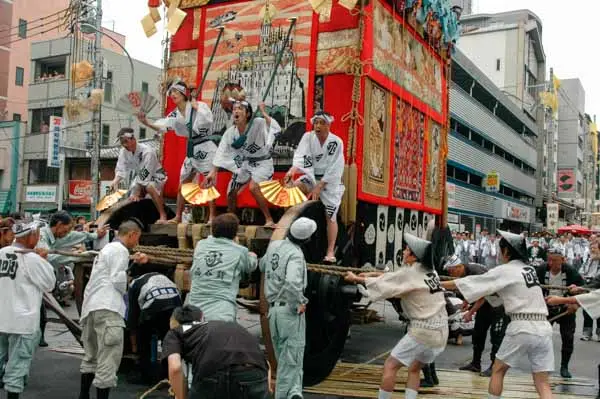But in those days the emperor believed that goryō or angry spirits were spreading illness to punish Kyoto. Goryō-e was a type of ritual to make peace with such spirits. So the emperor called for a goryō-e ritual involving 66 hoko or halberds, one for each region of the land. A halberd is a long spear or flag carried upright.
It seems the goryō-e ritual worked, because the next time pestilence struck, the emperor called for another one. Meanwhile, Kyoto’s annual rains and floods ensured that the rituals became tradition: by 970 C.E., the Gion Festival became an annual event.
As the Gion Festival history extended over centuries, the pacification of angry spirits became an extremely elaborate ritual purifying Kyoto, its downtown neighborhoods, people and visitors. This video explains what this means in our contemporary lives.
Over time the festival also expanded or shifted to supplicate the Shintō gods residing at the ancient Yasaka Shrine, in the nearby Gion neighborhood. Hence it’s known as the Gion Festival.
One of these important Gion Festival deities is the protector deity against epidemics, Gozu Tennō. He’s joined by and sometimes combined with the god of storms, Susanō no Mikoto, his consort and goddess of rice, Princess Kushi Inada, and their eight children. The two oldest books of Japanese history, the Kojiki and the Nihongi, describe the fantastic origins of Susano and Inada’s relationship.
Gradually the halberds began to include banners and umbrellas. Eventually they morphed into more complex and decorated yamaboko floats.
By the 14th century, each Gion Festival yamaboko float had become an opportunity for Kyoto’s rich kimono merchants to flaunt their worldly success and cultural sophistication. Japan’s rigid social strata kept merchants at the bottom, and strictly controlled their demonstrations of wealth.
The Gion Festival yamaboko floats presented a convenient loophole. With the floats, kimono merchants could both show off their wealth, and thumb their noses at higher social classes. Without getting into trouble.
In those days, everyone wore kimono, and downtown Kyoto was the center of the kimono industry. The Muromachi era was a Golden Age for arts and culture in Kyoto. And Muromachi-dori street is home to many festival yamaboko floats.
Each Gion Festival neighborhood vied with one another to have the most extravagantly decorated—and exotic—yamaboko float.
Kyoto was one of the ends of the Silk Road, and international influence meant power. Thanks to this, the Gion Festival culture remained international (particularly its yamaboko float themes and textiles), even after the Tokugawa Shogun almost closed the country’s borders to outside influence.
Even until the late 1900s, each Gion Festival community‘s activities were highly secret, and very competitive. There is more insider Gion Festival information published in my book than has ever been made public before, in any language.

Kankō Boko‘s ondo-tori “drivers” guide its team of rope-pullers in the tricky tsuji-mawashi corner-turning. The gigantic floats’ wheels only go straight!
Meanwhile, the 1150+ years of Gion Festival history persist as a symbol of humanity’s ability to rise above hardship. Frequent fires devastated central Kyoto up to the late 1800s. Regular illnesses related to summer rains continued into the late 1900s. Many Gion Festival patrons never returned from World War 2. After the war, U.S. Occupying forces banned public gatherings, including the Gion Festival. Nowadays nuclear fallout and climate change make our future uncertain.
The Gion Festival has survived it all, for more than a millennium. It’s a great symbol of sustainability, the enduring human spirit.
In these ways, the Gion Festival continues as a giant prayer for protection of Kyoto, its people, and visitors. It also serves as a celebration of the fleeting beauty of this world.